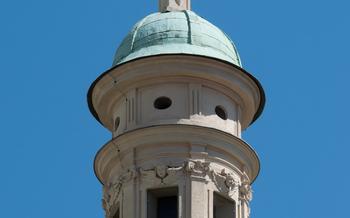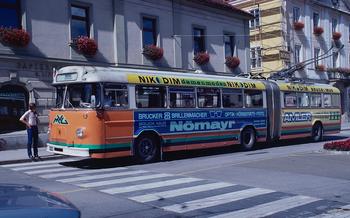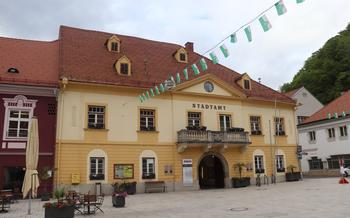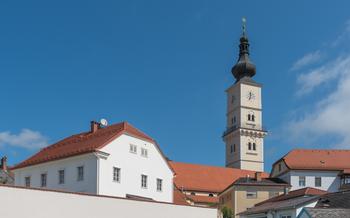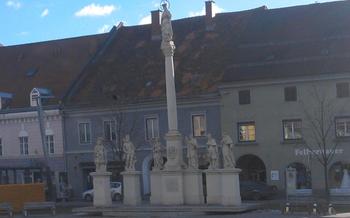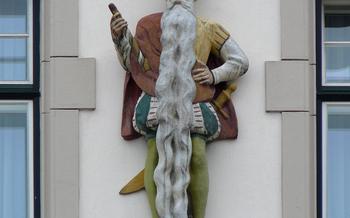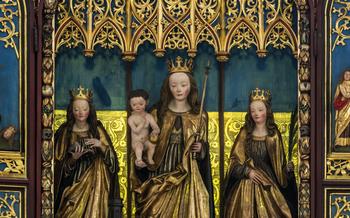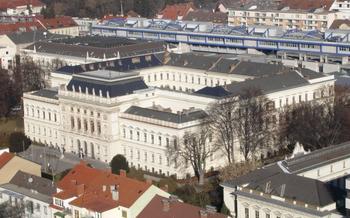
Frohnleiten Old Town
- Kapfenberg’s Neighbor, Frohnleiten:
- A Walk Through Time
- Exploring the Sights
- Shopping and Dining
- Events and Festivals
- Things to Do Nearby
- Practical Tips
- The Town Hall
- The Plague Column:
- The Parish Church
- The Capuchin Monastery
- The Frohnleiten Museum:
- The Old Cemetery
- The New Cemetery
- Insider Tip:
Kapfenberg’s Neighbor, Frohnleiten:
Situated just a short distance from the vibrant city of Kapfenberg, the charming town of Frohnleiten beckons travelers with its rich history, captivating sights, and idyllic ambiance. Nestled amidst the picturesque landscapes of Styria, Frohnleiten boasts a captivating past that dates back to the Middle Ages. Once a strategic trading post along the Mur River, the town flourished and evolved over the centuries, leaving behind a legacy of architectural wonders and cultural treasures.
The heart of Frohnleiten lies in its enchanting old town, where cobblestone streets wind their way past rows of colorful buildings, each with a story to tell. In stark contrast to the modern developments that have sprung up around it, the old town exudes an aura of timelessness and authenticity, transporting visitors back to a bygone era. The transition from the modern to the historic quarters is striking, offering a unique juxtaposition that adds to the town's allure.
Reaching Frohnleiten is a breeze, thanks to its excellent transportation links. Whether you choose to travel by car, train, or bus, you'll find that getting to this hidden gem is effortless. Once you arrive, prepare to be captivated by the charm and tranquility that await you in Frohnleiten.
A Walk Through Time
Frohnleiten's old town is a living museum, where every corner tells a story. The town's rich history is reflected in its architecture, from the Gothic Pfarrkirche to the Renaissance townhouses. The old town is dotted with landmarks and monuments that speak to its past, including the Schlossberg, a hill with a ruined castle that offers stunning views of the surrounding countryside, and the Stadtmuseum Frohnleiten, a museum dedicated to the town's history.
The best time to visit the old town is during the summer months, when the weather is warm and the streets are bustling with activity. However, the old town is also beautiful in the winter, when the snow-capped roofs and cobbled streets create a magical atmosphere.
No matter when you visit, be sure to take your time to wander through the old town's narrow streets and alleys. You're sure to discover something new and interesting around every corner.
Exploring the Sights
Frohnleiten's old town is a treasure trove of historic sights and landmarks. A stroll through its cobbled streets will take you past beautiful old buildings, charming shops, and historic monuments.
One of the most notable landmarks in the old town is the Pfarrkirche Frohnleiten, a stunning Gothic church that dates back to the 14th century. The church is adorned with intricate carvings and sculptures, and its interior is home to a number of valuable works of art.
Another must-see sight in the old town is the Schlossberg, a hill that overlooks the town. The hill is home to the ruins of a 12th-century castle, as well as a number of hiking trails that offer stunning views of the surrounding countryside.
Frohnleiten is also home to a number of museums, including the Stadtmuseum Frohnleiten, which is dedicated to the town's history. The museum houses a collection of artifacts and documents that tell the story of Frohnleiten's past, from its early beginnings to the present day.
The best time to visit Frohnleiten's old town is during the summer months, when the weather is warm and sunny. However, the town is also beautiful in the winter, when the snow-covered streets and buildings create a magical atmosphere.
Shopping and Dining
The old town of Frohnleiten is a great place to shop for souvenirs. The local shops offer a variety of traditional and modern goods, as well as local handicrafts. You can find everything from handmade pottery and glassware to traditional Austrian clothing and accessories.
The old town's restaurants offer a variety of culinary delights. You can find everything from traditional Austrian cuisine to international dishes. There are also a number of cafes and bars where you can relax and enjoy a drink or a snack.
Some of the best places to eat in the old town include:
• Gasthof Zur Post: A traditional Austrian restaurant serving classic dishes such as Wiener Schnitzel and Tafelspitz.
• Cafe Konditorei Kern: A cafe and pastry shop serving delicious cakes and pastries, as well as light meals.
• Ristorante Pizzeria La Piazza: A pizzeria serving authentic Italian pizzas and pasta dishes.
• Zur Linde: A pub serving local beers and wines, as well as traditional Austrian dishes.
Frohnleiten is a great place to sample the local cuisine. Be sure to try some of the region's specialties, such as Steirerkäs (a type of cheese), pumpkin seed oil, and Schilcher wine.
Events and Festivals
Frohnleiten is a town that loves to celebrate, and there are a number of events and festivals that take place throughout the year. The most popular events include the Frohnleiten Old Town Festival and the Christmas Market.
The Frohnleiten Old Town Festival is held every year in June and features a variety of events, including live music, dancing, food, and crafts. The festival is a great opportunity to experience the town's rich culture and history.
The Christmas Market is held every year in December and features a variety of stalls selling traditional Christmas gifts and decorations. The market is a great place to get into the holiday spirit and find unique gifts for your loved ones.
Other popular events in Frohnleiten include the Frohnleiten Wine Festival, the Frohnleiten Music Festival, and the Frohnleiten Sports Festival. These events are a great way to meet new people, experience the town's culture, and have some fun.
For more information on events and festivals in Frohnleiten, please visit the town's official website or contact the local tourist office.
Things to Do Nearby
Frohnleiten is surrounded by stunning natural scenery and historic towns, making it an ideal base for exploring the region. Just a short drive away is the city of Graz, the capital of Styria, with its beautiful Old Town, UNESCO World Heritage Site, and lively arts and culture scene. Another nearby city worth visiting is Leoben, known for its mining history and the impressive Göss Abbey.
For those who love the outdoors, the Gesäuse National Park is a must-visit. This stunning park offers a variety of hiking trails, from easy walks to challenging climbs, as well as opportunities for rafting, kayaking, and fishing. The Schladming-Dachstein region is another popular destination for outdoor enthusiasts, with its world-class skiing and snowboarding in the winter and hiking, biking, and climbing in the summer.
Practical Tips
Where to stay: Frohnleiten offers a range of accommodation options, from cozy guesthouses to modern hotels. For a truly authentic experience, stay in one of the town's charming bed and breakfasts, where you can enjoy traditional Austrian hospitality.
How to get around: Frohnleiten is a small town, so it's easy to get around on foot. However, if you're planning on doing a lot of exploring in the surrounding area, you may want to rent a car.
Cost of visiting: Frohnleiten is a relatively affordable destination. Accommodation, food, and activities are all reasonably priced.
What to pack: Be sure to pack comfortable shoes, as you'll be doing a lot of walking. Also, pack layers of clothing, as the weather can be unpredictable. And don't forget your camera, as there are plenty of photo opportunities in Frohnleiten.
The Town Hall
The Town Hall of Frohnleiten is a historic building that dates back to the 16th century. It is located in the heart of the old town and is one of the most recognizable landmarks. The building is a fine example of Renaissance architecture and features a beautiful facade with intricate carvings. The Town Hall is still in use today and houses the offices of the mayor and the city council.
The Town Hall was built in 1574 by the architect Domenico dell'Allio. It was originally used as a courthouse and prison. In the 19th century, the building was remodeled and expanded to accommodate the growing needs of the city government. The Town Hall is a popular tourist attraction and visitors can take guided tours of the building to learn more about its history and architecture.
One fun fact about the Town Hall is that it is said to be haunted by the ghost of a former mayor. The mayor is said to have died in a fire that destroyed the Town Hall in 167His ghost is said to wander the halls of the building at night, looking for his lost treasure.
The Plague Column:
The plague column in Frohnleiten is a poignant reminder of a dark time in the town's history. Erected in 1713, the column commemorates the victims of the plague epidemic that swept through the region in the 17th century. The column is adorned with statues of various saints, including St. Sebastian, the patron saint of plague victims.
The plague column is a powerful symbol of the resilience of the people of Frohnleiten. Despite the devastating impact of the plague, the town was able to rebuild and thrive. The column stands as a testament to the strength and determination of the human spirit.
The plague column is located in the center of the old town, in front of the parish church. It is a popular tourist attraction and a reminder of the importance of remembering the past.
Legend of the Plague Column:
According to legend, the plague column was erected on the spot where a young woman named Maria was buried. Maria was one of the first victims of the plague in Frohnleiten. She was said to have been a kind and compassionate woman who helped the sick and dying.
When Maria died, her parents buried her in a field outside the town walls. However, the next morning, her body had disappeared. The people of Frohnleiten were puzzled and frightened. They searched the entire town, but they could not find Maria's body.
A few days later, a shepherd was tending his sheep in the field where Maria had been buried. He saw a strange light coming from the ground. When he went to investigate, he found Maria's body. She was lying on a bed of flowers, and she was surrounded by a halo of light.
The shepherd ran back to town and told the people what he had seen. The people of Frohnleiten were overjoyed. They believed that Maria had been resurrected, and they carried her body back to the town. They buried her in the churchyard, and they erected a plague column on the spot where she had been found.
The plague column is a reminder of the suffering and death that the people of Frohnleiten endured during the plague epidemic. It is also a reminder of the hope and faith that helped them to survive.
The Parish Church
The Pfarrkirche Frohnleiten is a beautiful Gothic church that dominates the town square. It was built in the 15th century and has been enlarged and renovated several times over the centuries. The church is dedicated to Saint Michael, the patron saint of Frohnleiten.
The exterior of the church is characterized by its tall, slender spire and its large stained-glass windows. The interior of the church is equally impressive, with its high vaulted ceilings, its elegant columns, and its richly decorated altars. The most interesting feature of the church is its 16th-century fresco, which depicts the Last Judgment. The fresco is a masterpiece of late Gothic art and is one of the most important works of art in Frohnleiten.
The Capuchin Monastery
The Capuchin monastery was founded in 1630 by Count Johann Maximilian von Herberstein. He donated his castle as a site for the monastery and the first Capuchin monks arrived in 163The monastery was completed in 1636 and consecrated in 163The Capuchin monks played an important role in the religious life of Frohnleiten and the surrounding area. They provided spiritual guidance and support to the local population, and they also ran a school and a hospital. The Capuchin monastery was closed in 1784 by Emperor Joseph II as part of his reforms of the Catholic Church. The monks were forced to leave Frohnleiten, and the monastery was sold to a private owner.
After the monastery was sold, it was used for a variety of purposes. It was used as a school, a hospital, and a prison. In 1920, the monastery was purchased by the Catholic Church and it was reopened as a Capuchin monastery. The Capuchin monks returned to Frohnleiten and they have been living in the monastery ever since. The Capuchin monastery is a beautiful example of Baroque architecture. It is a large, two-story building with a red-tiled roof. The monastery has a cloister with a fountain in the center. The Capuchin monastery is a popular tourist attraction and it is open to the public. Visitors can tour the monastery and learn about its history. They can also visit the monastery's church and see the beautiful frescoes that decorate the interior.
A secret passage is a hidden tunnel that connects the Capuchin monastery to the parish church. The secret passage was built in the 17th century and it was used by the Capuchin monks to travel between the two buildings without having to go outside. The secret passage is still in use today and it is a popular tourist attraction. Visitors can take a guided tour of the secret passage and learn about its history.
The Frohnleiten Museum:
The Frohnleiten Museum is a local history museum that tells the story of the town and its people. The museum is housed in a 16th-century building that was once used as a granary. The exhibits include a collection of artifacts from the town's history, such as tools, clothing, and furniture. There is also a section on the town's role in the Second World War.
The most interesting exhibit in the Frohnleiten Museum is a collection of photographs that document the town's history. The photographs show the town's people, its buildings, and its streets over the years. They provide a fascinating glimpse into the town's past.
The Frohnleiten Museum is a great place to learn about the town's history. The exhibits are well-curated and informative, and the museum staff is friendly and helpful. If you are interested in learning more about Frohnleiten, be sure to visit the Frohnleiten Museum.
Currently, there is a temporary exhibit at the Frohnleiten Museum that focuses on the town's role in the Austrian Resistance during the Second World War. The exhibit features a collection of documents, photographs, and artifacts that tell the stories of the brave men and women who fought against the Nazi regime. The exhibit is a powerful reminder of the sacrifices that were made by so many to ensure the freedom of Austria.
The Old Cemetery
The old cemetery of Frohnleiten is a somber and atmospheric place. It is located on a hill overlooking the town, and its weathered headstones and crumbling walls tell a story of a bygone era. The cemetery dates back to the Middle Ages, and it was used as the town's main burial ground until the 19th century. Today, it is a protected historical site, and it is a popular destination for visitors who are interested in the town's history.
The old cemetery is home to a variety of graves, including those of wealthy merchants, farmers, and laborers. There are also a number of unmarked graves, which are believed to belong to the victims of the plague. The most famous person buried in the old cemetery is the composer Franz Schubert, who died in Frohnleiten in 182Schubert's grave is marked by a simple headstone, which bears his name and the dates of his birth and death.
The old cemetery is a place of great beauty and tranquility. It is a reminder of the town's rich history, and it is a place where visitors can come to pay their respects to the people who have shaped Frohnleiten's past.
Ghost story:
According to local legend, the old cemetery is haunted by the ghost of a young woman who died of a broken heart. The woman's name was Maria, and she was engaged to be married to a young man named Johann. However, Johann was killed in a hunting accident, and Maria was so grief-stricken that she died of a broken heart.
It is said that Maria's ghost can still be seen wandering the cemetery at night. She is often seen wearing a white dress and carrying a bouquet of flowers. Maria's ghost is said to be harmless, but she is known to make strange noises and to move objects around.
The New Cemetery
Established in the late 19th century, the new cemetery of Frohnleiten is a beautiful and peaceful place. Here you'll find a wide variety of graves, from simple headstones to elaborate monuments. The most famous person buried here is the composer and conductor Heinrich von Herzogenberg, who died in 1900. His grave is marked by a large and impressive monument.
Another interesting grave in the new cemetery belongs to a young woman named Maria. She died in 1865 at the age of 2According to the legend, she was engaged to a young man who died in a tragic accident. Maria was so heartbroken that she died of a broken heart. Her grave is adorned with a beautiful statue of an angel, and it is said that her spirit still haunts the cemetery.
The new cemetery is a great place to take a stroll and learn about the history of Frohnleiten. It is also a peaceful place to remember loved ones who have passed away.
Insider Tip:
Frohnleiten hides a fascinating gem: the Waldschwimmbad Frohnleiten. This tucked-away treasure is an idyllic natural swimming pool located in the midst of a lush forest, offering a serene escape from the bustling city. Surrounded by towering trees and the gentle sounds of nature, the pool invites visitors to immerse themselves in its refreshing waters, bask in the warm sun, and reconnect with the tranquility of the natural world. It's the perfect spot for a rejuvenating day trip, a picnic with loved ones, or simply a moment of peaceful solitude. Remember to bring your swimsuit and embrace the beauty of nature at this hidden oasis.
